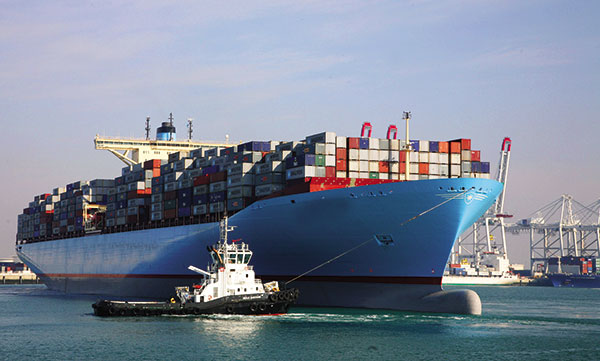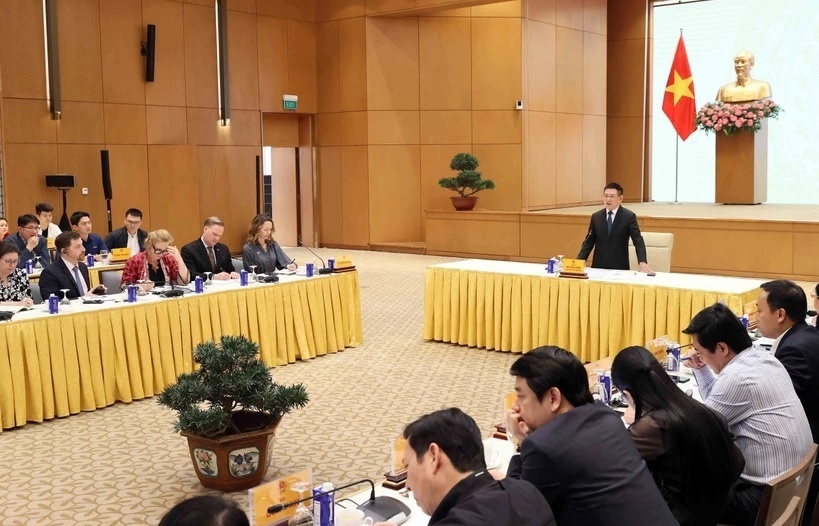A tale of many seaports: FDI and its expectations
 |
| There have been debates over whether optimism is riding too high in the development of Vietnam’s new seaports |
After getting a long-awaited green light from the Ministry of Transport in early November 2017 for an adjustment to the development of the My Thuy International Seaport project, authorities from the central province of Quang Tri are preparing to submit the project’s detailed investment plan to the government.
The plan explains how the project will be developed in three phases, instead of building all berths at once as originally planned. Four berths will be developed by 2020 during the initial stage, and the two subsequent stages will each see another three berths built.
“The adjustment will not affect the investment opportunities for foreign investors. The potential investor – My Thuy International Port Joint Venture Company (MTIP) – has finished the feasibility study of the project,” a senior official of the Quang Tri Department of Planning and Investment told VIR.
The project has so far attracted 14 investors, including Singapore-based Dinamo and a South Korean firm with solid experience in port management.
Quang Tri is not the only locality in Central Vietnam that is preparing to develop a large-scale seaport. Danang is also calling for investment in the Lien Chieu Seaport project, to cash in on growing trade and interest among international groups in such seaport projects and other economic sectors.
Danang is working with the Ministry of Transport (MoT) on the scale and capacity of Lien Chieu Seaport, with an estimated investment sum of over VND7.9 trillion ($359 million), half of that to be sourced from private investors under the public-private partnership format.
Japan Port Consultants Ltd. has joined the project’s prefeasibility study, submitted to MoT for approval. It is one among many domestic and foreign companies interested in the project, including TT Group and DMH IMEX Co., Ltd.
In the northern region, other cities and provinces are also in the mega-port race, with the involvement of many foreign investors.
In Haiphong, Lach Huyen International Gateway Port is under construction. This project has attracted the interest of Molnykit Co., Ltd. – a joint venture between the Japanese firms Mitsui O.S.K Lines Ltd., Nippon Yusen Kabushiki Kaisha, and Itochu Corporation, and US-invested Cargill Vietnam.
Vietnamese shipping giant Vinalines is also seeking permission to invest in some berths of the project in anticipation of rising trade in the area and its surroundings.
Haiphong forecasts that the volume of goods to be expected is 35 million tonnes a year during the 2020-2025 period, and 118 million tonnes a year by 2030.
In related developments, the $316 million Dam Nha Mac seaport and industrial zone (IZ) complex in Quang Ninh is being invested by Cayman Islands-based CDC Corporation, Singapore-based Middle Utilities Company Pte Ltd, and Hong Kong-based Infra Asia Investment Ltd.
According to Quang Ninh authorities, once operational, the 1,100-hectare project will produce an average of VND1.02 trillion ($46.5 million) in yearly revenue, VND389 billion ($17.7 million) in after-tax profit, and contribute VND240 billion ($10.9 million) to state coffers.
Balance of supply-demand
“Cities and provinces with sea access all want to build a seaport because it will bring huge benefits to them, including facilitation of imports and exports and an increase in state budget collection and job creation,” Nguyen Ngoc Hue, chairman of the Vietnam Association of Port-Waterway-Offshore Engineering (VAPO), told VIR.
Under the country’s seaport development planning by 2020, with a vision towards 2030, My Thuy Seaport will work as a transhipment port for goods in the East-West Economic Corridor. It is expected to serve IZs in the Southeast Economic Zone and other IZs in the province, as well as handle goods in transit for Laos and the north-eastern region of Thailand.
Quang Tri hopes that My Thuy Seaport ill lure many local and foreign strategic investors to invest in the zone, with Vietnam’s Becamex and Vingroup, Thailand’s Amata, and South Korea’s Hyundai already interested.
However, Quang Tri’s forecast about the volume of goods shipped via My Thuy Seaport is much higher than the 1.1 million tonnes by 2020 and 1.5 million tonnes by 2030 projected by the relevant planning for ports of Group 3 via this central province. Thus, the investment plan was met with objections among other localities and MoT.
“In Group 3’s outlines layed out for the group of central ports by 2020, with a vision towards 2030, they are forecast to accommodate 10,000-50,000 deadweight tonnage (DWT) vessels. However, in the plan for My Thuy Seaport, 100,000DWT vessels are proposed,” said the Thua Thien-Hue People’s Committee in a document sent to the Ministry of Planning and Investment.
Moreover, the committee added, My Thuy’s forecast on its capacity of 13.5 million tonnes by 2020 and 27 million tonnes by 2025 is unreasonable, as it makes up nearly one-fourth of the total volume of goods shipped via these ports.
According to MoT, the proposed project has not yet accounted for the forecast volume of future goods or the port’s scale and capacity.
“Though we agreed with the adjustment plan for My Thuy Seaport, we proposed that the province carefully assesses the sources of goods volume and investment efficiency, while directing the investor to a detailed investment plan in line with the growth in goods-transportation demands,” said a senior MoT official.
Regarding Lien Chieu Seaport, the senior official said that the volume of goods shipped via seaports in Danang has a high growth rate, and the handling capacity at nearby Tien Sa Port should not surpass 10 million tonnes in order to prevent traffic jams and protect the environment. Building Lien Chieu Seaport will help ease the overload at Tien Sa Port.
“The city wants to build a large-scale seaport in Lien Chieu, but we suggested it should have a development process linked to the real demand to ensure operational efficiency for both existing and future demand,” the MoT official added.
Of the same view, VAPO’s Hue said that building Lien Chieu, My Thuy and other seaports is necessary if the demand of goods shipped via them increases. But these localities should consider correct timing and appropriate scale to ensure their feasibility, economic efficiency, and environmental protection.
“The planning of a seaport development is necessarily made from forecasts of goods to be shipped via the port, based on the socio-economic development strategy of the country, the region, and each locality. The facts have proved that incorrect forecasts were made due to many objective factors. This happens all over the world, and in Vietnam as well,” Hue added.
In fact, ports in some localities have been operating ineffectively due to rampant investments. Cities and provinces want to build large-scale seaports to accommodate big vessels, but in doing so they have sometimes parted ways with the national seaport development planning.
“Forecasts could be different with what might happen in the future because of changes in social issues, natural disasters, and global issues, which have significant impact on these forecasts,” Hue said.
In looking at the development of the Cai Mep-Thi Vai port complex in the southern province of Ba Ria-Vung Tau, one can see a good example of making the wrong forecasts on the future volume of goods.
This area is home to seven ports, including five in the Cai Mep area. There are two foreign joint venture ports, SSIT and CMIT, and three domestic ones, Tan Cang-TCIT, Tan Cang-TCCT, and Tan Cang-TCTT.
Under the national planning, the port area was designed to have a total capacity of around 3.8 million twenty-foot equivalent units (TEUs) by 2020. However, five years ago, they were built with a total capacity of seven to eight million TEUs.
As a result, these ports have endured years of trouble in attracting cargo. Although container throughput in ports in the Cai Mep area has improved significantly, by the end of last year, the total capacity of ports in the Cai Mep-Thi Vai complex was just three million TEUs.
Ho Kim Lan, general secretary of the Vietnam Ports Association, once told VIR, “Current legislation and business environment conditions for seaport development and operations remain problematic. The problems include shortfalls in comprehensive and sustainable port master planning and development, insufficient infrastructure to ensure connectivity in port operations, requirements to improve market conditions with more transparency, and sound competition which could only be handled and improved by new port reform legislation.”
In a move to enhance port operations and investment efficiency, MoT has proposed the establishment of a port management agency – the first specific regulatory mechanism for seaports in Vietnam. However, it has not yet been approved.
By Bich Thuy
What the stars mean:
★ Poor ★ ★ Promising ★★★ Good ★★★★ Very good ★★★★★ Exceptional
Latest News
More News
- Successful lifting of Long Thanh International Airport central terminal steel roof structure (April 04, 2025 | 12:00)
- Belgian royals attend inauguration of service-office complex in Quang Ninh (April 03, 2025 | 14:36)
- Foreign groups keen on smart manufacturing (April 02, 2025 | 14:46)
- Technology startups must deliver coherent value (April 02, 2025 | 14:41)
- Smart Chinese manufacturing forms a win-win collaboration (April 02, 2025 | 14:34)
- Manufacturers raise the bar to become suppliers for Intel Vietnam (April 01, 2025 | 18:02)
- Vietnam gaining an edge to leapfrog traditional tech hubs (April 01, 2025 | 13:49)
- Foreign investment attraction flourishes on better business climate (March 31, 2025 | 15:50)
- Quang Tri to start work on $232 million airport next year (March 31, 2025 | 11:49)
- Binh Dinh greenlights 62 ventures worth $8 billion (March 31, 2025 | 11:32)
















 Mobile Version
Mobile Version